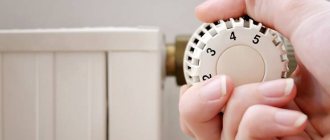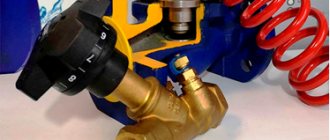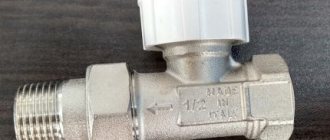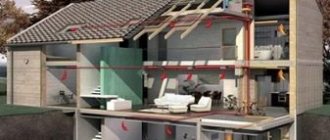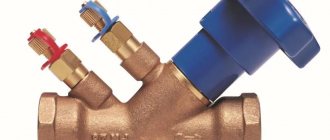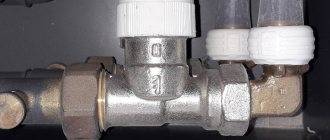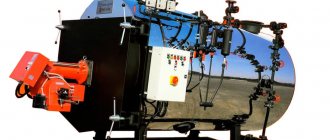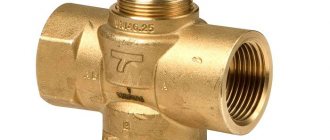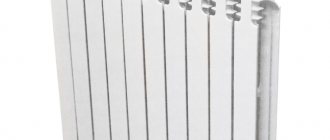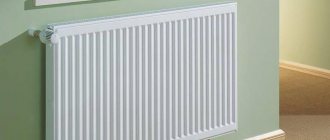Few people know, but it turns out that the speed of water flow in a home water supply can be controlled from a distance. To do this, instead of a conventional valve, a magnetic valve is installed. Let's figure out where such a useful device can be used, how it works, and what types of it exist. Read to the end and learn how to independently and competently purchase the necessary part.
Magnetic valve with control sensors Source aquacenter.es
Bottom connection valve for sectional radiators
What needs to be inserted into the battery in order to most easily change the flow from the bottom to the top of the heating battery.
Problems with airing radiators arise when the transit heat flow is very intense - the flute effect. For example, if you use a classic “Leningrad” (single-pipe heating system) to run a large amount of very hot coolant. At the same time, close the lower valve located at the bottom of the radiator return and close it. This is necessary to explain the “flute” effect. As soon as we have closed the return tap on the battery, however, it may not be a tap, but some kind of connection - a fitting for connection in which there will be a rather narrow diameter of the internal section, for example, the main thing is that the main flow in the heating branch could capture the return flow using the ejector principle. Cases of airing of radiators with saddle connection schemes are very common.
That's why it is with a saddle connection - (bottom bottom) that the radiators begin to work as air collectors. And on such radiators, it will be difficult to get rid of it with a Mayevsky tap. You will have to install an automatic air vent so that it constantly releases the air that constantly collects in the heating radiators.
Watch a video about airing the saddle or bench heating branch.
Of course, the customer’s requirement may be unambiguous - I want to reduce the connection to the radiator and that’s it.. But there is no need to prove that this is an incorrect connection. It’s better to just take a closer look at all the options for bottom connection of heating radiators and understand that not all radiators connected from below are saddle-connected. For example, panel radiators have a bottom connection that is not a saddle/bed connection due to the fact that the supply in the panel radiator design is made from above through a copper tube hidden inside the radiator.
Typically, sectional radiators with tube inlets are located on the sides are connected to a saddle circuit. So, a plug is twisted into the upper fittings on one side, a Mayevsky tap on the other side, and an inlet and an outlet at the bottom.
Such a saddle connection will air the battery until the coolant flow is raised upward using a special plug. To do this we need a lower radiator connection valve. Which will not only prevent the heating battery from airing, but will also increase heat transfer by 25%!
This is the bottom connection valve.
Its function is to completely block the transit flow moving along the bottom of the radiator and redirect it to the upper area of the battery so that, as they say, it does not become airy and warms up well. As it is shown in the video.
The issue of correct and at the same time aesthetic connection of a radiator is quite popular among those who are concerned about installing heating in an apartment. You may also find interesting the material on how to install a heat flow extender inside a radiator, useful for lateral connections.
Recommendations
There are standards for the interaxial distance at the bottom connection terminals of radiators with bottom connections. Although, perhaps not standard ones like the Rifar Monolit Ventl, which is wider than its standard counterparts, which are sold in a wide range on the market...
Polypropylene piping The cost of such work to install a heating radiator in an apartment on pipes with a jumper and shut-off valves comes out at a price of around 2 -2.5 tr. For taps and pipes, the cost of the entire piping will be…
Source
Strapping elements
The heating device in different circuit configurations can be equipped with:
- Shut-off valves are ordinary ball valves designed to completely disconnect the device from the circuit. The ball valve has only two operating positions - “open” and “closed”.
Let us clarify: adjusting the permeability with the help of this fittings is possible in principle, but it is very difficult due to the impossibility of accurately adjusting the position of the valve shutter. In addition, intermediate positions of the valve accelerate wear of the seats (Teflon or fluoroplastic rings in the valve body) due to suspensions contained in the coolant.
It is not advisable to use ball valves to regulate heat transfer.
- Chokes . A throttle, or radiator control valve, allows for manual adjustment of the flow of the supply line and allows flexible adjustment of the heat transfer of the device.
- Thermostats . The thermal valve for the heating radiator makes it possible to automatically adjust the heat output depending on the room temperature.
- A manually controlled air valve (Maevsky valve), which serves to bleed air.
- Automatic air vent , performing the same functions without the participation of the owner.
Where is a solenoid valve needed?
A solenoid valve is one of the types of shut-off valves that can operate automatically, without human intervention. They provide a section of the pipeline that moves both any liquid and gaseous medium. And if a failure occurs at a given interval in the line, the valve blocks the flow.
The mechanism can also be programmed in the opposite direction. Under certain conditions, it will open the way to a liquid or gaseous medium. And to perform the required task, various sensors are programmed. It is they who supply the signal to the magnetic coil (solenoid).
Main applications of solenoid valve:
- Household sphere.
- Reclamation.
- Industry.
- Heating systems.
The basic purpose of the solenoid valve is to distribute water evenly, which most often occurs in doses. And a regular timer is set to open the system. And in the household sector, the mechanism is installed in public toilets, automatic showers and various washing systems. For example, car washes.
Solenoid valve with timer Source air-post.info
An electromagnetic solenoid with a timer is widely used for watering greenhouses and lawns, as well as garden plots and fields planted with cultivated plants. Such mechanisms are used in arid regions not only for land reclamation. They are installed in the water supply system for residential buildings. And each district of the city receives the scarce liquid according to the schedule.
But in heating systems, the valve performs protective functions. And its main task is to shut off the hot water supply in the event of a pipeline rupture. But the main purpose of the solenoid valve is to prevent a possible accident. And control sensors help him with this.
For a heating system, it is very important to constantly monitor the pressure inside the circuit and the temperature of the liquid medium. If these two parameters reach a critical value, the solenoid closes the shut-off valves in the pipeline until they return to normal.
The industry also widely uses automatic shut-off valve in many of its applications. They are also used in various production facilities where various components need to be mixed. And they serve as a kind of dispensers.
Watering the lawn using a solenoid valve Source magazun.com
See also: Catalog of companies that specialize in engineering systems (heating, water supply, sewerage and others) and related work
Design and principle of operation
Ball valve
Its bolt is a chrome plated brass ball with a high quality surface finish. To reduce friction when turning the shutter and to seal its connection with the body, a pair of saddles is used - rings made of heat-resistant plastic with a low coefficient of friction. The rod is equipped with a handle and sealed with a ring made of the same plastic or heat-resistant rubber.
Throttle
A control valve for radiators is, in essence, a type of screw valve: a threaded rod, when screwed in, gradually closes the hole in the seat. The device dictates the requirements for installing the throttle: the coolant must flow to the seat from below; the direction of its movement is indicated by an arrow on the body.
The radiator angle valve is used to throttle the supply line.
Useful: chokes can be used both for adjusting heat transfer depending on weather conditions, and for one-time balancing of heating devices (for example, in two-pipe heating systems, where in order to uniformly heat the radiators, the passage of the connections of the devices closest to the boiler must be artificially limited).
Thermostatic valve
This is a type of throttle whose design involves changing the working position of the rod with an additional device - a thermal head.
Thermal head
The device works in conjunction with a thermostatic valve.
There are two types of thermostatic heads on sale:
- Bellows uses an extension of a bellows filled with a liquid or gas with a high coefficient of thermal expansion to change the position of the rod. The low price (from 400 rubles) is accompanied by limited functionality: a thermal head of this type is only capable of maintaining the set temperature around the clock. To make adjustments, use a scale with the degree of air heating indicated on it.
Nuances of selection and installation
When purchasing the type of electromagnetic shut-off valve, you need to pay attention to two points. Initially, you need to study the parameters of the pipeline. So that the inlet and outlet openings of the valve completely coincide with the diameter of the line. Otherwise, the water flow may slow down. And this is fraught with an increase in pressure and temperature in the system.
It is equally important to study the specification. The manufacturer must indicate for which systems its products are intended. The description gives the minimum and maximum permissible values for the internal temperature, as well as pressure and flow rate.
It is always necessary to take into account the conditions and chemical composition of the product that will move through the pipeline. For example, acid will corrode the brass body of the device. And too hot water can destroy the plastic shell.
Installation of a magnetic valve in a heating system Source master-vodoved.ru
Exotic
Several other devices are used relatively rarely and are little known to the general public.
- The thermoelectric radiator valve actuator can be used with any throttling valves. It is an externally controlled servo drive powered by batteries or AC power.
The photo shows a closed thermoelectric valve.
- The internal spring valve for the radiator is a stainless steel valve with a spring that closes the manifold of the first section when the passage plug is screwed into it. The purpose of its installation is to limit circulation through the lower collector of the device, ensuring its uniform heating throughout the entire volume. (See also the article Manifold pipe routing: features.)
The damper restricts circulation through the lower manifold.
The valve for the lower connection of the radiator is equipped with a thermostatic head.
Thermostatic valve for a heating radiator: purpose, types, principle of operation + installation
When installing heating systems in private houses, heat exchange radiators with water supply through a pipeline located in the floor under the screed are often used. This arrangement of pipes allows you to efficiently and aesthetically supply the coolant to the heat exchange devices through the lower connection of the radiator.
The connection is made from below using steel or aluminum panel radiators that have outlets at the bottom with external threads at a standard distance from each other. The radiator is connected to pipe outlets in the wall or floor using angled or straight N-shaped adapters with an American screw connector on the outlet pipe (they are also popularly called “binoculars” because of their similar appearance).
Rice. 1 Connection nodes for heating radiators - varieties
Why is a thermostatic valve needed?
The valve solves two problems: maintains the room temperature at a comfortable level and saves energy.
But in order for it to really cope with such functions, you need to understand in what cases the device is appropriate and how to install it correctly.
If in the middle of winter there is a need to open the windows so that the temperature in the room drops to an acceptable level, a thermostat is definitely needed. But it won’t help when the radiators are barely warm—it will probably make it even colder.
In the second case, it is better to try to regulate the temperature in the room differently: change the volume of coolant in each radiator, adjust the operation of the boiler (for a large area), select the optimal circulation pump or adjust the operation of the existing one.
The price of a thermostat ranges from several hundred rubles (200-600), so re-equipment of the heating system will not be expensive. But there are also expensive models
As a temporary measure, control valves can be used. But it is not recommended to use ball valves for these purposes.
Types of magnetic valves
There are models that can only open the passage to the flow. After the magnetic field in the coil disappears, the spring will return the rod to its place. Such devices are installed in irrigation systems. Models that only cut off the flow of liquid are mounted in heating circuits. Such mechanisms are called one-way ones because they are the simplest.
But there are also bistable samples that perform both functions. Usually equipped with various sensors. At the command of some, movement opens to the flow. Others, as a rule, monitor various disturbances in the system and give a signal to close the valve.
Such models come in two and even three-way types. In the first case, they prevent the reverse flow of water flow. In the second, they can mix liquids with different temperatures.
Solenoids can use either AC or DC current. To connect to pipes, use either a thread or a flange. The control element can also be used in different ways. The piston may move inside the locking mechanism. There are also models with membranes or spools.
Magnetic valve design Source banbas-nn.com
Regulatory elements
Control valves are automatic and are designed to set and maintain the optimal temperature indoors.
If the climate in the room changes sharply, the system will work: the speed of coolant flow through the pipes will change, which will gradually return the indicators to normal.
Inside the regulator is a substance that changes its dimensions, depending on the situation in the heating system. When expanding, pressure is exerted on the valve rod, which smoothly shuts off the liquid supply.
The installed device should not be influenced by external factors; it should be located away from heating elements and direct sunlight. Do not cover it with curtains, push furniture in, or place the product near an air conditioner or ventilation hole.
Regulating products include thermal heads, check valve, bypass valve, and automatic air vent.
Design and operating features of the device
Let's look at how a thermostatic valve works and on what principle it works.
How does a thermal valve work?
The device consists of two main working elements - a valve and a thermostatic head. The first is most often made of brass, sometimes nickel-plated, its lower part blocks the pipe, and its upper part continues the pressure rod and spring.
Valves are also available in bronze (nickel-plated or chrome-plated), as well as stainless steel. The latter are rare and expensive.
What happens inside the valve? The head device contains a sensitive element. It is located in a cavity with gas or liquid (bellows).
Heating provokes expansion in this environment, the element is pushed forward, pressing on the rod, spring, and later on the valve. The force of pressure determines the degree of overlap.
The figure shows a device with liquid in a bellows. Gas thermostats react faster to temperature changes (5-10 minutes), but are also more expensive. There is no significant difference from this during operation
Briefly about the main thing
All you need to know about the magnetic valve is that it requires electricity and various control equipment to operate automatically. For example, a timer programmed for a certain time will send a signal to the induction coil. The latter drives the plunger on the valve, built into a regular water supply.
The raised rod will open a passage for water, and a strictly calculated portion of liquid will fall into the flower pot. And the amount of required moisture will be measured by a special meter. He will then send his signal to the same coil. And this time the electromagnetic field pushes the rod into place, blocking the flow of water.
We understand the types of devices
According to the method of adjustment, valves are divided into mechanical and automatic . The first require manual rotation of the mechanism for narrowing the flow in the pipes.
Both devices perform the same function - they adjust the flow of coolant to the radiator in accordance with the parameters set by the user, but using automation is less troublesome
Automatic models do not require manual adjustment. When the temperature around the thermostat decreases, they independently detect this and adjust the coolant flow.
Manufacturers also offer different thermostat designs:
- Common for two-pipe systems - the simplest device. If you need hydraulic linking of radiators along one branch, it is recommended to add a shut-off and control valve to the supply (return) circuit.
- With hidden and open hydraulic superstructure - such devices have a coupling with an internal rod, so hydraulic adjustment is possible.
- For single-pipe, gravity systems - due to the increased passage, the throughput of these devices is increased to 5.1 m3/hour, so they can be installed in non-pressure systems.
- 3-way for circuits with bypass - they can regulate and distribute the coolant in conjunction with the bypass. When the set temperature reaches the valve, the coolant is sent to the bypass; when it drops, the bypass is partially closed.
The percentage of thermal valves for two pipes is much greater than for single pipes, and the latter in our country are about 80%.
This is due to the fact that the device was originally invented for the former, where the coolant is distributed among the devices forcibly under high pressure. Pre-setting by valves is designed to distribute pressure evenly throughout the system.
Only some manufacturers have valves for single pipes - Heiz, Danfoss, Heimeier, Oventrop.
In single-pipe schemes, you cannot use conventional “two-pipe” thermostats : they have a lower capacity, they can only operate with a large difference in pressure between the supply and return, so there will be a risk of redirecting the coolant to the bypass.
Externally, “one-pipe” valves are larger in size.
Three-way valves are appropriate in circuits with a solid fuel boiler, as well as for flow separation and bypass piping of radiators. The device can also be used in single-pipe installations
Thermostatic valves also differ in shape. They can be straight, angular or included in sets with jumpers for pipes. Direct ones are suitable for regular batteries. Angular ones are needed in schemes with lower pipe connections, when the CO is partially disguised under the floor.
A separate type of thermal valves is electronic. They have wider functionality than regular ones. With their help, you can set different room temperatures for each day of the week and even hourly.
Electronic thermal heads are more expensive and larger than usual: inside the case there is a compartment for two batteries. There are models with removable and built-in control units
Electronic thermostats provide significant savings in coolant consumption. If there is no one in the apartment or house from 8 am to 6 pm, the device will properly maintain the minimum temperature. And when the owners arrive, it will heat the premises to a comfortable level.
Valves with anti-vandal casing are also available for sale. They are reliably protected from unqualified intervention and are suitable for installation both in a home with small children, and in kindergartens and schools.
Types of locking mechanism
According to the type of constipation, all water valves and taps are divided into two types:
- Valve;
- Ball;
- Cork.
Below we will take a closer look at the features of all types of these devices.
Valve
Valve taps are locking mechanisms familiar to everyone. The principle of their operation is based on blocking the passage with an elastic gasket mounted on the rod. The position of the rod is adjusted by a handwheel using a worm mechanism.
So, when the handle is rotated, the rod rises, as a result of which the passage for water opens.
Among the advantages of this mechanism it is possible to highlight:
- Ability to withstand high pressure;
- Ability to manage the flow;
- Ease of Management;
- Possibility of repair.
Along with the advantages, these products also have some disadvantages:
The gasket quickly fails because it comes into contact not only with water, but also with the iron surface. Indeed, it is possible to replace it yourself. In most cases, the device kit includes an assembly drawing of the water valve, which demonstrates how to disassemble the mechanism and replace broken parts.
- To completely open or block the passage, you need to make a couple of turns with the flywheel yourself, which is not very comfortable.
- The mechanism is less durable than other types of fittings.
Due to these circumstances, recently such taps are installed quite rarely, only in those cases when it is necessary to regulate the flow.
Ball
Ball water valves have recently become the most common. They took this name due to the fact that the locking mechanism is made in the shape of a ball with a through hole. To block the flow, the ball is rotated with its hole perpendicular to the pipeline.
The plumbing ball valve has a number of advantages, such as:
- Durability due to the simplicity of the mechanism;
- Tightness when the passage is closed;
- To open the passage, you need to rotate the handle only 90 degrees;
- Affordable price;
- Possibility of use in conjunction with servos and other devices that allow you to control the mechanism remotely or install it in automatic flow shut-off systems. (See also the article How to choose a faucet: highlights.)
As for the shortcomings, there are few of them:
- The operating instructions for the device imply its use only for completely blocking or opening a passage, i.e. it cannot be used to regulate flow. Otherwise, the mechanism will quickly depressurize.
- If the mechanism fails, it cannot be repaired.
This type of fittings is used much more often in plumbing systems.
Cork
The design of a plug-type water valve resembles a valve valve, the only thing is that the flow is shut off using a conical plug, which is attached to the stem. When the rod is lowered, the plug enters the hole and closes the passage well.
It should be emphasized that in water supply systems such fittings have recently been used very rarely, since more durable ball valves are installed instead.
Heating wiring diagrams
They are distinguished by the following characteristics:
- The number of pipes - single or double pipe. With a single-pipe distribution, hot water sequentially passes through all the radiators of one riser. It is clear that the first of them receives more heat, the last - less. Ensuring uniform heat distribution is achieved by using a tap at the battery inlet and a bypass - a pipe of smaller diameter that creates a path for water to bypass the radiator.
- The location of the risers is vertical or horizontal.
- Organization of circulation - natural or with an installed circulation pump.
When organizing a heating system for an apartment in a multi-story building, you have to rely on the already installed wiring. For example, in Soviet-built houses, single-pipe vertical distribution with a natural coolant circulation was used. When renovating such premises, you have to adapt to this, although it has more disadvantages than advantages. Strictly speaking, there is only one advantage - the length of the pipes is half that of the two-pipe version.
In modern construction, attention is constantly paid to saving energy resources. You can save heat, including by quickly regulating its output and choosing the optimal heating mode
Therefore, new buildings are often initially equipped with a two-pipe heating system. With higher initial costs, it opens up opportunities for effective management of energy consumption.
Area of use
The use of electromagnetic valves is carried out in a variety of areas of human activity, wherever there is a need to control the flow of liquids and gases remotely. This includes:
- Domestic heating systems.
- Water supply and water treatment systems.
- Technological installations.
- Pipeline transport.
- Heat generation and distribution.
- Appliances.
- Sewerage.
- Irrigation.
- Vehicles.
Features of installation and connection of the valve
The device itself is simple, but special attention must be paid to installing and calibrating the thermostatic valve on radiators. Correct installation will ensure the accuracy of the device.
What factors are considered during installation? A type of thermal valve is for one-pipe or two-pipe. Plus the direction of movement of the coolant - it comes from below or from above.
On the valve itself, the direction of movement of the coolant is indicated by an arrow. According to this marker, it is necessary to install thermostats on radiators, otherwise the device will not work correctly
Hot water supply pipes to the battery are supplied in different ways. It depends on the heating scheme. The placement of plugs and thermostats are also different. The general recommendation for most thermostat models is to place them within 40-60 cm from the floor level.
The installation algorithm is approximately as follows:
- Disconnect the radiator from the heating system and drain the water.
- We remove the section of the horizontal pipe and the tap too.
- The thermostat can also be mounted in the radiator cap if a shut-off valve is installed in front of it. Or make an insert into the horizontal part of the pipe in front of the battery.
- The tightness of the joints is important. We provide this by standard winding of FUM tape onto the threaded area.
The traditional connection diagram is as follows: bypass - ball valve - thermostat.
One more point: there are systems where the coolant moves in different directions in different rooms. This is especially true for U-shaped risers.
Installation nuances for one-pipe and two-pipe systems
In a single-pipe system, hot water circulates through one pipe with radiators connected in series. The coolant pipe goes into the top of the batteries. The latter runs through the installation, exits from below on the same side and is sent to the main highway.
Single-pipe CO is considered ideal for private buildings and apartment buildings up to 5 floors. In other cases, it is recommended to install a two-pipe CO
In a one-pipe system, the thermostat is placed on an unregulated bypass. This jumper connects the direct pipe and the return pipe, so hot water moves freely after the pressure is blocked by the valve.
Such a jumper can be welded to the pipe yourself, for which a piece of pipe with a diameter of no more than 8 cm is suitable. In this case, you need to prepare holes in the appropriate places.
Standard and recommended thermostat installation diagrams for one-pipe and two-pipe CO systems. The figure shows how to connect a valve with a jumper (bypass) and a foot valve
In a two-pipe system, the coolant enters the radiator through one pipe and is discharged through the other. A bypass is not needed; the thermostatic valve must be installed on the water supply pipe.
Rules for adjusting the operation of the device
After installation, you need to adjust the operation of the device. To do this, we first close the windows and doors - we insulate the room to prevent heat leakage.
- We turn on the heating.
- We set the valve to the position of maximum heat transfer and measure the temperature.
- We are waiting for the room temperature to rise by 5 degrees and become constant.
- Close the valve and wait for a comfortable temperature.
- Then we open the thermostat a little bit until we hear the sound of passing water. The body of the device itself should become warmer.
- The last point needs to be remembered.
In a private home, air must be bleed from the batteries before adjustment. In this case, maximum care must be taken to avoid the release of hot steam.
When more than three batteries are connected to the boiler, each thermostat must be opened to a different level so that the heat is distributed evenly throughout the rooms
The adjustment starts from the coldest room. It needs to be warmed up well before moving on to other rooms.
Frequent installation errors and possible problems
The first mistake is placing the thermal head vertically. The problem is the hot metal valve under the head: hot air flows upward from it.
This air heats the head, and it mistakenly turns off the radiator. As a result, the battery is almost always disconnected and the room does not warm up. The device must be installed horizontally (“head” into the room).
In the instructions for the thermostat, the diagrams show how and where to install it in different cases, but there is not a single diagram with a vertical arrangement. If it doesn’t work vertically, you need to use devices with remote sensors
The second mistake is the location of the thermostat where the temperature differs from the real one in the room. Example: in a niche with a battery. In this option, the head will always be “hot”.
A significant malfunction in its operation will also be present when placing curtains behind thick fabric, under window sills, or at the edges of window openings.
If it is impossible to position the thermostat otherwise, a model with a remote sensor will again help out. They differ from conventional devices by the presence of a capillary tube about 2 meters long with a temperature sensor at the end. You can attach such a device on the wall away from the window and radiator.
Models with a remote element determine the temperature more accurately than conventional devices due to their location at a distance from the radiator, but they also cost much more.
Heads with remote regulators are also available for sale, the installation of which can be done anywhere at a distance of up to 15 m from the battery and valve. There are also electronic heads that are controlled by thermal computers.
The thermostatic valve completely blocks the coolant flow. If in a radiant heating system all devices do this at the same time, there will be problems with the boiler. A possible solution is bypass valves on the circuits.
If there are 2-3 radiators in a room, does it make sense to install thermostats on each radiator? Will there be conflict between them? In this case, you need to do balancing using tuning valves (ball valves).
Types of battery taps
Designed for installation on a battery
:
- shut-off valves for radiators (half-turn ball valves);
- air release valves (manual Mayevsky valve, automatic air vents);
- balancing valves for radiators;
- control valves equipped with thermal heads (thermostatic valves);
- taps for draining coolant.
To decide which taps to install on heating radiators, you need to understand the operating principles and purpose of each device.
Mayevsky crane
This is a manual air valve for a heating radiator, which allows you to remove air pockets from the radiators. Instead of a mechanical Mayevsky faucet, it is possible to install an automatic air vent, but these products do not look as aesthetically pleasing.
The Mayevsky tap consists of a polymer body into which a threaded washer is soldered into a through cone-shaped hole. From the outside, a cone of appropriate dimensions, also equipped with a thread, is screwed into the washer. To screw in and unscrew the cone, there is a recess for a screwdriver or a special key, which is included in the product package.
Schematic representation of the Mayevsky crane
There is also a plastic washer on the body with a hole through which air is released. To do this, insert a screwdriver or key into the recess and turn the cone one turn. When water begins to flow from the hole, the shut-off cone is screwed back in all the way.
Important! It is recommended to install the valve with a recess for a screwdriver, as the key may get lost. Under no circumstances should you unscrew the shut-off cone completely - the pressure in the system will not allow you to install it back
Ball valves: types and parameters
When installing each radiator, it is advisable to install two ball valves or a ball valve for the supply and an adjustment valve for the return. Ball valves are shut-off valves that allow you to shut off the flow of coolant and dismantle radiators without draining the coolant from the entire system.
Ball valve device
The key element of the device is a steel ball with a hole for the coolant to pass through. The ball is fixed to the rod, and when the handle is turned 90 degrees, it turns and completely blocks the flow of the medium.
Ball valves vary
:
- according to the body material (brass, silumin, polypropylene);
- by design (straight and angular);
- in terms of throughput (for full-bore ones, the hole in the ball practically coincides with the diameter of the pipe, for standard ones it is 70-80% of this indicator).
When considering which taps are best installed on radiators, preference should be given to full-bore ones, since they do not reduce the permeability of the system and do not reduce the heat transfer of heating devices.
Valves with thermal heads
The thermostatic valve for a heating radiator makes it possible to control the temperature in the room. Depending on the model, the thermal head is adjusted to a certain temperature manually, or the operation of the valve is flexibly regulated by an automatic device. Under the influence of the thermal head, the valve stem moves, changing its flow area.
Valve with thermal head
If the installed thermal valve does not have the function of blocking the coolant flow, it is additionally required to install a shut-off valve in order to fully service the battery.
Flushing taps
The flush valve on the radiator is designed to drain the coolant while flushing the system. The design of the welded flushing valve includes a metal body, a rubber gasket and a long stem. To open such a tap, use a gas key or pliers.
This device has a significant drawback - the rubber gasket is easily destroyed during operation of the crane, which leads to an emergency. Instead of a welded flush valve, it is recommended to install a radiator plug or an adapter with a plug valve on the radiator.
Balancing valve
The balancing valve for heating makes it possible to adjust the temperature conditions of the heating circuits. If the radiator is not equipped with a thermostatic valve, use a mechanical tuning valve, the diameter of which is manually set based on the pressure readings in the pipeline in the sections before and after the valve.
In systems where the battery temperature is adjusted using thermostatic valves, an automatic control valve is responsible for balancing the pressure. The balancing control valve is mounted on the return pipe.
Where can I buy
The Teplograd company catalog presents a wide range of radiator taps and other components for the installation of heating systems and water supply systems. The main advantages of cooperation with our online store are:
- Large selection of products;
- Delivery to the site;
- Various payment options;
- Help from experienced consultants when choosing fittings;
- Reasonable prices.
Additional information about the terms of purchase is presented in the relevant sections of our website. If you have any difficulties, contact our managers. We wish you pleasant shopping!
Source
